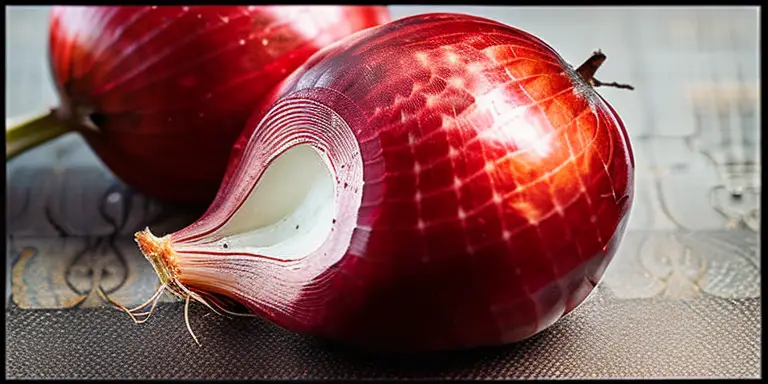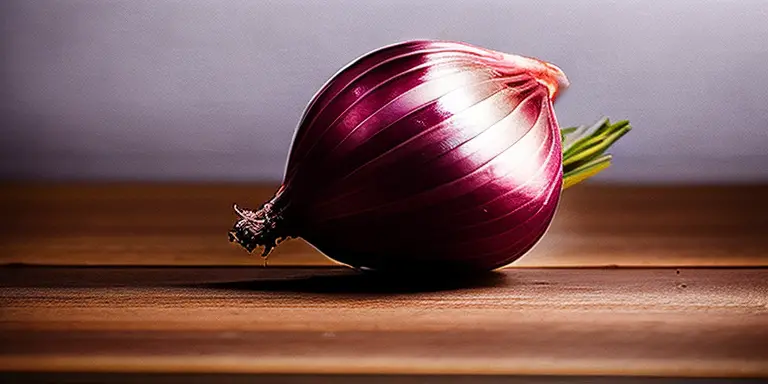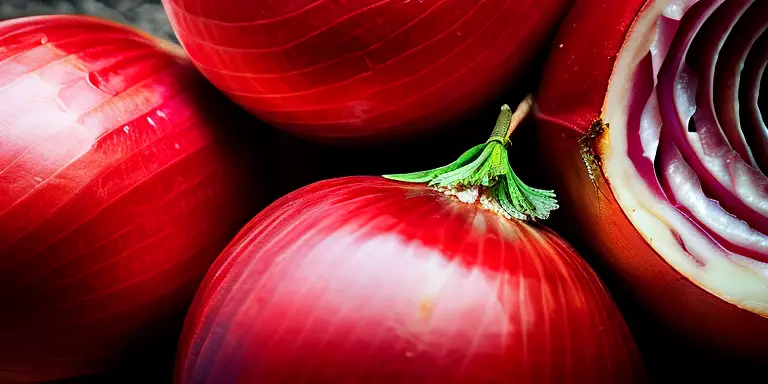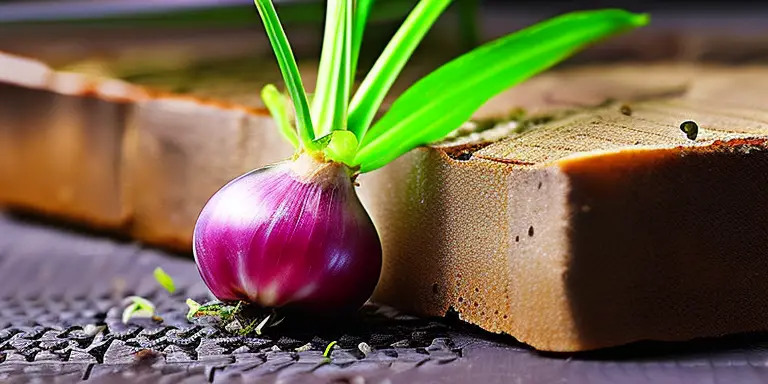Do you prefer red onions in salads, sandwiches, or stews? Can red onions go bad and cause food poisoning or waste? It’s important to know how to tell if a red onion is bad to avoid risks and enjoy its flavor. Don’t worry. Your search ends here. Red onions are delicious and nutritious in salads, stir-fries, and soups. Red onions have a relatively short shelf life, so it’s critical to understand when an onion is no longer edible. Understanding the signs of a bad onion can help you avoid food poisoning and keep your food fresh. Thankfully, we’ll show you how to spot a bad onion and how to store them properly. Read on to learn more.
If you read over the article will come to know sings of a bad red onion, the best way to restore onion, the freezing process of onion without the smell, symptoms of eating bad onions, when chopped onions are bad, how long do red onions last normally and can you eat bad onion or not. Let’ start.
What Are The Signs Of A Bad Red Onion?
The visual appearance of a bad red onion is one of the most common signs. If the red onion has mold or black spots, is mushy, smells strange, or has a slimy texture, it is bad and should be discarded. A good onion should be firm with no brown or black spots. Bruises on the bulb’s flesh usually cause spots. As with any other product, inspect your onions thoroughly before using them in your cooking. Furthermore, the smell of onion can indicate whether or not it has gone bad. A bad onion has a strong odor that can be unpleasant or off-putting. It will be easy to tell if your onion has gone bad. Eventually, fresh onions smell like onions, whereas bad onions smell bad. If your onion or other vegetable becomes soft, squishy, or slimy, it is turning and should be discarded. Squishy onions should be thrown away without hesitation. You can find details of the signs to look out for here:
Visual Examination

A visual examination is essential when determining whether a red onion is bad. When inspecting the onion, look for any signs of spoilage, such as brown and black spots, soft spots, or mold. If the onion is firm and has dry, papery skin, it is probably still edible. Furthermore, when squeezed, the flesh should be firm and moist. If the onion feels soft and dried, it is probably past its prime and should be avoided.
Soft Spots

Soft spots are among the most common signs of a bad red onion. Soft spots indicate that the onion has begun to degrade and can indicate decay. A good red onion should have no soft spots and be firm. If you notice any soft spots on your red onion, throw it away immediately. Discoloration, a foul odor, a slimy texture, and sprouts may accompany soft spots. These indicators point to a bad red onion, which should be discarded for safety.
Smell
Another key indicator of whether a red onion has gone bad is the smell. Bad onions have a strong and sour odor, whereas good onions have a mild odor. If you notice your onion emitting a strong odor, it’s probably time to toss it. It is also important to note that if the onion has been chopped, it will spoil faster and should be consumed within a few days. Soft spots, slimy texture, mold, and black spots are all signs of decay. If you notice these symptoms, your onion is no longer edible.
Texture

One of the most telling signs of freshness is the texture of the onion. A good onion will be firm and dry to the touch. If it feels soft, slimy, or mushy, it’s probably bad and should be thrown away. To check for soft spots, lightly press your finger or thumb against the onion’s surface. It’s best to throw it out if there are any soft or spongy spots. It’s also worth noting that sprouting onions can still be used even if they don’t appear as fresh as new ones.
Sprouts

Sprouts are easy to tell if your onions are past their prime. If you notice any green stalks sprouting from the onion that resemble green onions or scallions, it’s time to throw them out and start over. While sprouted onions can be cooked, it is not recommended because they have a much weaker flavor and texture than fresh onions. As a result, it’s best to err on the side of caution and toss any onions that show signs of sprouting.
Color
The color of a red onion can indicate whether it is bad or not. A good onion is brightly colored with no dark spots or blemishes. If the onion has a dull color or wrinkled skin, it has passed its prime and should not be eaten. Furthermore, if the red onion has turned brown or black, it has gone bad and should be discarded immediately.
What Is The Best Way To Store Onions?
When it comes to ensuring the longevity of your red onions, storage is critical. Red onions last a month when stored properly. Keep them cool, dry, and out of direct sunlight to prevent sprouting. Plastic bags and containers trap moisture and spoil onions faster. Hang red onions in a warm, dry place to dry them out permanently. Mold and discoloration indicate decay. This shows a spoiled onion. Knowing how to store onions—red, yellow, or white—improves cooking and health.
You can easily store things by following these simple guidelines. It will help you get the most out of your red onions and let you enjoy their sweet, savory flavor for a few weeks.
- Choose the right onion
Different types of onions require different storage conditions based on moisture content, thickness, and pungency. Sweet onions like Vidalia or Maui onions are more delicate and should be stored in the refrigerator. In contrast, pungent onions, such as Spanish or red, can be stored at room temperature.
- Maintain a dry and cool environment for onions
Onions thrive in a dry, cool environment with low humidity and good ventilation. Onions can be stored in a mesh bag or basket or individually wrapped in paper towels or newspaper. Plastic bags and containers should be avoided when storing onions because they can trap moisture and promote spoilage.
- Store onions away from other foods
Onions can absorb the odors and flavors of other foods, such as potatoes, apples, or citrus fruits. To avoid this, keep onions separate from other products and in a separate compartment or shelf.
- Label the container and date the onions
Label the container with the type and date of the onions to avoid confusion and waste. This will allow you to keep track of their freshness and use them in the order in which they were received. Onions can be stored properly for several weeks or months but lose flavor and potency over time.
How To Freeze Onions Without The Smell?
Freezing onions is an excellent way to increase their shelf life and keep them on hand for future cooking projects. One disadvantage of freezing onions is that the odor can linger in your freezer and kitchen. The good news is that there are some methods for freezing onions without causing them to smell. You can store onion freeze without the smell by following these tips.
- Preparing the onions
Begin by peeling and chopping the onions to the size you desire. If you prefer, you can slice them. Next, place the onions in a colander and rinse them under cold running water for a few seconds. This will help remove any excess dirt or debris and reduce the amount of juice the onions release when frozen.
- Blanching the onions
Blanching is a technique that involves briefly boiling and then cooling the onions in ice water. Blanching onions can help preserve their texture and color while reducing their odor. Bring a large pot of water to a boil and add the onions to blanch. Boil for 1-2 minutes, then transfer the onions to a bowl of ice water with a slotted spoon. Allow the onions to cool for a few minutes before draining and patting dry with a paper towel.
- Preparing to freeze the onions
After you’ve prepped and blanched the onions, they’re ready to be frozen. To store the onions, use a freezer-safe bag or container. Remove as much air as possible before sealing the bag or container to avoid freezer burn. You can also write the date and contents of the bag or container on it for future reference. Freeze the bag or container for up to six months in the freezer.
How To Tell If Chopped Onions Are Bad?
Understanding how to tell if chopped onions are bad is critical, as they can go bad quickly and become unsafe to eat. To determine the freshness of chopped onions, look for mold or soft spots and a pungent, somewhat acrid odor. Onions that have been boiled may develop dark spots and become mushy. The texture of the onion should be firm and free of brown or black spots, usually caused by bruises on the bulb’s flesh. Fresh onions have an onion odor, whereas bad onions have a strong, unpleasant odor. Finally, if your onion or other vegetable feels soft, squishy, or slimy, it has most likely gone bad and should be discarded.
The Symptoms Of Eating Bad Onions
Bad onions can cause symptoms ranging from mild to severe. You can feel it when you eat. Nausea, vomiting, abdominal cramps, and diarrhea are mild symptoms. Fever, headaches, fatigue, and even anaphylaxis can be severe symptoms. If you are sensitive to the compounds in onions, eating bad onions can cause food poisoning or an allergic reaction. To avoid these symptoms, it is critical to recognize the signs of a bad onion. Visual inspection and smell are two simple ways to determine if your onion has gone bad. Feel for soft spots or sprouts as well. Finally, if your onion has changed color or appears decaying, it should be discarded. You can protect yourself from illnesses by following these tips and being aware of the signs of a bad onion.
Can You Eat A Bad Onion?
Generally speaking, you can get sick from eating a bad onion. Even though it is rare, bad onions can contain bacteria that can make you sick if eaten. Before eating onions, inspecting them for signs of spoilage is critical. A red onion should not be eaten if it has soft spots or discoloration, emits an unpleasant odor, or has sprouted. To avoid this, store onions in a cool, dark place and use them within a few weeks of purchase. If you are unsure whether an onion is safe to eat, it is best to throw it away because eating a bad onion can cause nausea, vomiting, abdominal cramps, and diarrhea.
How long do red onions last?
Red onions can be stored at room temperature for 2 to 4 weeks and in the refrigerator for up to 3 months. It is best to keep them away from humidity, sunlight, and high temperatures to extend their shelf life. Red onions should also be stored in a cool, dry place with good air circulation. Wrap them in a paper towel or store them in an unsealed container or bag to extend their shelf life further. You should discard onions if you notice any spoilage, such as mold, black spots, slimy texture, foul odor, or soft spots.
Conclusion
Hopefully, now, you must know how to tell if a red onion is bad or not. You can tell if an onion has gone bad by using your senses, such as smell and sight. Look for signs like bruises, brown spots, soft spots, and sprouts. Also, pay attention to how the onion feels and smells to see if there are any signs that it is going bad. If these things are true, you should throw the onion away and not eat it. If you store onions correctly, they will last longer and be safe to eat. Properly storing and preserving onions can save money, reduce food waste, and always have fresh, flavorful onions for cooking.


